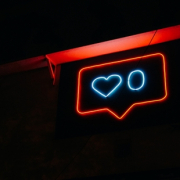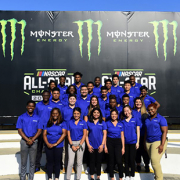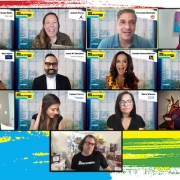What we learned at supper: PRSA members on Race and Diversity in the Workplace
By: Tyrone Law, Diversity & Inclusion Committee Member and Veronica Figueroa, Diversity & Inclusion Chair for the PRSA Orlando Chapter
Racial inequality is not new in this country. But following a year marred with racial unrest after the death of George Floyd, social justice issues have been brought to the forefront through national conversations about systemic racism, police brutality and social injustice.
The power of these conversations was undeniable, and organizations across the country felt compelled to respond by releasing statements against racism, making donations to civil rights groups, and sharing anti-racism resources with their stakeholders. However, as corporations pledged a role in combating systemic racism, the public was quick to point out that many of those organizations’ track record on representation and diversity within the C-suite and in marketing did not line up with their statements.
The events that transpired in 2020 were the basis of PRSA Orlando’s third annual Dinner, Diversity and Dialogue gathering, where eight PRSA Orlando members of diverse backgrounds discussed race and diversity in the workplace. Attendees brought their unique experiences and perspectives to the conversation and discussed tangible building blocks to help move forward D&I practices in the field of public relations from theory to practice. The COVID-19 pandemic shifted the conversation from in-person to virtual, and the Anderson-Devitt Foundation, a family foundation that seeks to help the community be a better place to live, covered the cost of the virtual dinner.
According to the Bureau of Labor Statistics, the ethnic makeup of the public relations industry in the U.S. in 2019 was 87.9% White, 8.3% Black, 2.6% Asian American, and 5.7% Hispanic American. This statistic sparked a dialogue that made the attendees contemplate some fundamental questions: As a community of public relations professionals, where do our core values lie? Are the typical public relations industry hiring and career advancement opportunities equal across the board? Are we intentional as it relates to the authenticity and delivery of our communications efforts?
Be Authentic
Companies and organizations have to be authentic in their D&I efforts. The only way to achieve this is for them to build diverse teams at all levels, as well as a workplace culture that is genuinely inclusive. That means including Black, Indigenous, and People of Color (BIPOC) employees in decision-making processes. For example, companies who released statements in support of the Black Lives Matter (BLM) movement need to have an understanding of Black culture and experience, not just at the lower level, but also in the C-Suite, otherwise their message will not be well-received. “Start at the bottom, promote from within, invest in your team, and train people at all levels to avoid drive-by D&I,” one PRSA Orlando member suggested.
Representation Matters
Nobody wants to feel alone. During the discussion, one of our attendees shared that “it is draining to attend meetings and events where no one looks like you.” And while diversity is important, the key to reaping the benefits of a diverse workforce is inclusion. For example, simply hiring BIPOC will not boost employee morale, unless those employees are allowed to share their voice and opinion, paving a path of trust and active involvement.
Studies have shown that younger generations view cognitive diversity as a necessary element for innovation and ideal teamwork. This means that inclusion of people who have different styles of problem-solving and can offer unique perspectives given their backgrounds is becoming more and more important to companies as they look to build thriving, in sync teams.
Companies that do not prioritize D&I, may not be able to attract the top-tier talent who expects to see a diverse mix of backgrounds represented to help brainstorm new ideas, strategies and tactics. For example, an attendee shared that as a Hispanic woman entering white-dominated spaces, it was difficult to relate to her counterparts or share ideas because she didn’t have the same experiences they did growing up.
Another member shared that in order to attract diverse candidates, hiring managers need to put in the work. “As public relations professionals, we have to seek out candidates who are not applying. We can’t assume that underrepresented demographics are aware of the job opportunities we are posting about,” the member said. “In the past, I’ve called potential candidates who hadn’t applied or who hadn’t heard of the role. We should be bending over backwards to build diverse and inclusive teams.”
Empower BIPOC Voices
While there is still much work to be done, many companies and organizations are making strides toward hiring more diverse talent, or “walking the walk,” but that is just the first step. Once they’ve been hired, companies must also be intentional about retaining, empowering and promoting them.
Attendees suggested in-person or online training at every level, from interns to the executive level, intended to address unconscious biases and help teams understand and embrace each other’s cultures and backgrounds. Businesses with D&I at the forefront of their corporate consciousness encourage employees to be their authentic selves. This empowers team members to share creative, out-of-the-box ideas that would have otherwise not been shared.
“Employees do their best work when they are comfortable,” one member said. “We sometimes don’t realize that some of our colleagues are anxiously making mental calculations throughout the day trying to blend in. Am I dressed okay? Did I say the right thing? It can be exhausting, but it is how many BIPOC employees navigate work on a day-to-day basis.”
“I feel most empowered when my leaders and colleagues get to know me, allowing me to show my true self at work,” another member chimed in. “My previous employer made an effort to hire diverse candidates and ensured everyone felt included. It gave me the confidence I needed to share ideas, which led to a promotion.”
Implementing D&I measures that allow employees to feel comfortable at work should be a part of the DNA of every organization, and should be displayed from the hiring process and beyond.
Creating Genuine and Authentic Campaigns & Messaging
In order to market well to an audience, companies need to understand their perspectives, and what is important to them. Consult with players on the team who can provide insight into a specific culture relevant to the campaign. Marketing creatives and communicators need to be comfortable in telling their leadership that messaging is inauthentic, according to one attendee.
When asked about brands that have made an impact through authentic messaging, one attendee mentioned the 2018 P&G ad “The Talk” which addressed the conversations Black Americans have had with their children about racism and the realities of discrimination throughout the years. Unsurprisingly, the agencies that worked on the Emmy Award-winning ad featured diverse teams, and understood the Black experience.
Attendees also discussed companies and brands that have missed the mark, such as Adidas. In public and on social media, Adidas condemned racism and called for unity and change, but behind closed doors employees felt the long inaction on racism and discrimination within the company was related to its senior leadership. As one attendee put it, “Adidas profited from Black culture, without addressing its internal problems.”
A sports league that fumbled the ball with its Black Lives Matter messaging was the NFL. In September, NFL Commissioner Roger Goodell said that the league would stencil “End racism” and “It takes all of us” in the end zones at each stadium. He shared that, “the NFL stands with the Black community, the players, clubs and fans confronting systemic racism.”
The move was seen as ironic and widely criticized, given the fact that the NFL did not support San Francisco 49ers player Colin Kaepernick for kneeling during the national anthem in protest of police brutality and racism in 2016. He has not played since his contract ended in 2017, and has not been picked up by other teams in the league since.
“[The NFL] could’ve been the first to take a stand and been a leader years ago,” one member shared. “Instead they blackballed players and think we will forget because they took a stand this year. It doesn’t seem genuine, you can’t make it right, and people remember that.”
“I am young in the sense that I am not jaded, but it starts to ring hollow when brands take these stands and then move on,” another member said. “You have to show you are genuine and you have to be comfortable with being uncomfortable.”
Moving Forward: How PRSA Orlando Can Support D&I In PR and Membership
- Outreach to high school students. Think about ways to give high school students the opportunity to learn about the public relations industry, develop and hone their skills, and network with industry professionals, who they may not otherwise have had the opportunity to connect with and learn from.
“I didn’t even know that public relations was a potential career path I could strive for when I was in high school,” one member shared. “If PRSA Orlando’s intention is to fuel the industry with diverse talent, it should find ways to connect with BIPOC high school students to introduce the idea of communications as a career to them, or create a mentorship program where students can shadow PR professionals.”
- Develop dynamic relationships with multicultural organizations. “I’d love to see PRSA Orlando connect with other community organizations and groups that are dedicated to breaking barriers and promoting D&I,” a member suggested.
In Central Florida, there are countless professional organizations that work to promote and advance BIPOC businesses and professionals, and the attendees agreed that PRSA Orlando should be more strategic in building relationships with underrepresented groups in order to further strides and promote D&I in the profession at large.
- Tightening it up at home. Throughout dinner, attendees mentioned the importance and value of meeting public relations professionals who “looked like them,” and several thoughts and ideas on this topic were discussed, such as assigning a designated outreach committee for new members, connecting with them one-on-one, introducing them to other members, and making a targeted effort to invite new members to events.
Make D&I Part of Vision and Mission
By being inclusive to different demographics, public relations professionals can open themselves and their businesses to more viewers, customers, and clients that they would otherwise miss. A diverse workforce is not only great for the employees who work for you, but also for your company and your bottom line. Everyone agreed that companies and organizations need to make D&I part of the vision and mission. If it isn’t, their D&I efforts will always be seen as reactive.
Welcome Your Insights
We welcome suggestions from our PRSA Orlando members on how we can help communications professionals address diversity and inclusion in the profession and at large.
Please reach out to PRSA Orlando’s 2021 Diversity and Inclusion Chair, Veronica Figueroa, to continue the discussion.











